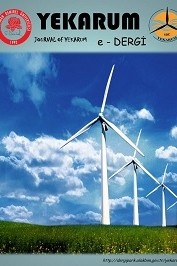Theoretical Investigation of Solar Gasification of Different Types of Lignite Coal
Scope of this to investigate the steam-gasification in solar assisted gasification reactor of three types of lignite coal that produced in Turkey was investigated. In this gasification process, heat was supplied from solar energy. Using of solar energy as process heat, the discharge of pollutants is avoided, the gaseous products are not contaminated by combustion products and the calorific value of the fuel is upgraded [1]. Turkey is a rich country in terms of reserve of lignite coal. But these lignite coal reserves have got high ash, humidity and sulphur rates and low calorific value of fuel. From this view, it is necessary to use these coals with gasification for avoiding the discharge of pollutants and upgrading the calorific value of the fuel. Furthermore, these coals are most appropriate fuel type because, they allow sensitive combustion, doesn’t leaves waste materials such as slag, ash, etc allows high combustion temperatures [2]. In this study, exergy and irreversibility calculations which are related coal type of reactor, heat exchanger and quencher are carried out from data obtained from literature and given as tables. Finally, the exergetic efficiency expressions for different coal types are obtained.
Anahtar Kelimeler:
coal
___
- [1] Steinfeld, A., Zedtwitz, P.V., “The Solar Thermal Gasification of Coal-Energy Conversion Efficiency and CO2 Mitigation Potential”. Energy, Switzerland. 2003.
- [2] Onat, K., “Kömürün Gazlaştırılması”, Isı Bilimi ve Tekniği Dergisi, Cilt 9, Sayı 3, s.19-26, 1986.
- [3] Borat, O., Balcı, M., Sürmen,A., “Yanma Bilgisi”, s.261, 1992.
- [4] Pişkin, S., “Kömür gazlaştırma”, Kömür(Editör: Kural Orhan), İTÜ Maden Fak., Maden Müh. Böl., Şubat 1991.
- [5] Belyaev, A.A., Yampolskii, Yu.P., Starannikova, L.E., Polyakov, A.M., Clarizia, G., Drioli, E., Marigliano, G., Barbieri, G., “Membrane air seperation for intensification of coal gasification process”,Fuel Processing Technology, vol.80, pp.119-141, 2003.
- [6] Cho, H.C., Lee, Y.K., “Reactor performance with primary/secondary swirl intensity and direction in coal gasification process”, International Journal of Energy Research, Vol.25, pp. 1151-1163, 2001.
- [7] Steinfeld, A., “Solar hydrogen production via a two-step water splitting thermochemical cycle based on Zn/ZnO redox reactions”, International Journal of Hydrogen Energy, Vol. 27, pp.611-619, 2002.
- [8] Epstein, M., Ehrensberger, K., Yogev, A., “Ferro-reduction of ZnO using concentrated solar energy”, Energy, 2003.
- [9] Tüsiad, Turkey Energy Report,2003
- [10] Telli, Z.K., “Yakıtlar ve Yanma”, Akdeniz Üniversitesi Isparta Mühendislik Fakültesi Yayınları, Yayın No:17, 1984, Isparta.
- [11] Çengel, Y.A., Boles, M.A., “Mühendislik yaklaşımıyla termodinamik”, McGraw-Hill Literatür Yayıncılık, Ekim 2000, İstanbul.
- [12] Telli, Z.K., “Termodinamik (Problemleri ile Birlikte)”, Palme Yayıncılık, 3. Baskı, s.275, 1998.
- [13] You, Y., Hu, E.J., “A medium-temperature solar thermal power system and its efficiency optimization”, Applied Thermal Engineering, pp.357-364, Australia, 2002.
- [14] Üçgül, İ., Koyun, T., “Silindirik yansıtıcılı iki yüzeyli kollektörler ile düz yüzeyli kolektörlerin I. ve II. yasa verimliliklerinin irdelenmesi”, Mühendis ve Makine, Sayı:530, Mart 2004.
- [15] Kotas, T.J., “The exergy method of thermal plant analysis”, 1985.
- [16] Szargut, J., Moris, D.R., Steward, F.R., “Exergy analysis of thermal, chemical and metallurgycal processes”, hemisphere publishing corporation, 1988.
- Başlangıç: 2010
- Yayıncı: Süleyman Demirel Üniversitesi
Sayıdaki Diğer Makaleler
Theoretical Investigation of Solar Gasification of Different Types of Lignite Coal
